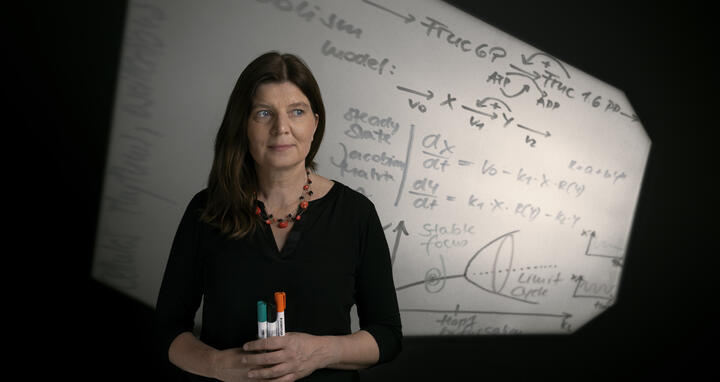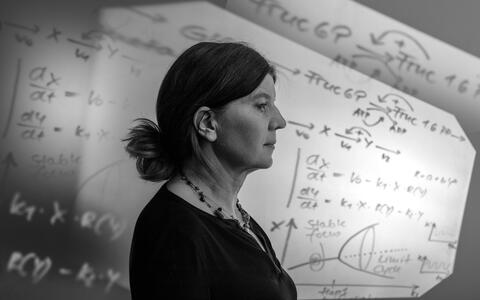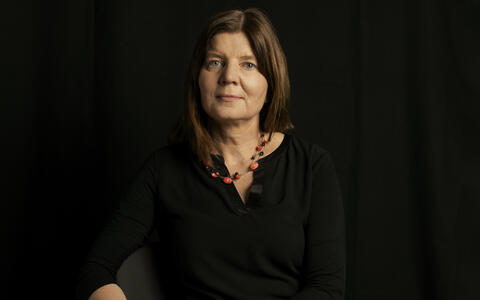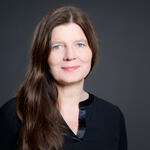The modeler of life
Several pens lie next to each other on Professor Jana Wolf’s desk, organized by color: red, green, blue, and a couple of others. Wolf reaches for a black one and starts to draw a cellular transport process: a black circle represents the cell, a smaller black circle inside is the mitochondrion, and a red arrow shows how glucose molecules diffuse through the cell membrane from the outside. After sketching out several more steps, she visualizes the molecules latching on to the mitochondria and how they together supply the cell with nutrients.
Using paper and colors helps me get an overview and think about how things fit together.
“Using paper and colors helps me get an overview and think about how things fit together,” says Wolf. She exudes that orderliness typical of mathematicians – as well as an irrepressible creativity that fuels her thought processes. She puts her pens aside; this was just a brief demonstration of the most creative part of her work, which involves turning molecular knowledge and ideas into drawings and formulas before translating them into complex models on the computer. “Theoretical work needs to address questions like: What processes are involved? How do they interact? How do I bring everything together? And how do I represent that mathematically,” she says.
To get an overview on paper: Jana Wolf's colored pencils.
Jana Wolf is a committed theoretical scientist. She combines existing knowledge of biochemical mechanisms and signaling pathways in cells – such as those that enable the breakdown of glucose – with experimental and patient-specific data in order to develop mathematical, computer-based models of disease processes. A vital component of this approach are multi-omics data: the mountains of data that are produced by high-throughput technologies and depict the totality of all genes and proteins in individual cells, or even their metabolic processes. Wolf wants to condense these data into models that properly reflect the complexity of the processes in the body and come as close as possible to reality.
Computer models for personalized therapies
I see no way forward for medicine without computational modeling and theoretical approaches.
“Cells receive an incredible number of signals from their environment, such as from growth factors and nutrients, and these signals are processed via sophisticated cellular networks that trigger a reaction in the cell’s nucleus. The cell then decides, for example, to divide more frequently or to initiate cell death,” explains Wolf. Extensive nonlinear models are required to mathematically describe these sorts of decision-making processes. Once the formulas are in place, they can be used, for example, to depict perturbations in signaling pathways and to predict how cells will react to external influences. “For complex diseases like cancer, which involve the perturbation of many signaling pathways at once, it would actually be impossible to process the mass of data and develop personalized therapies without computer models,” says Wolf. “I see no way forward for medicine without computational modeling and theoretical approaches.”
The windows of Wolf’s office at the Max Delbrück Center for Molecular Medicine (MDC) in Berlin-Buch look out over the tops of the trees outside. This green, leafy view helps the scientist to think when she looks up from her sketches or screen, or to clear her mind when she goes on brief strolls. Wolf works with a variety of experimental and clinical research groups here on campus and at Charité – Universitätsmedizin Berlin. Some want to understand disease processes by looking at the metabolism of cells, others focus more on signaling pathways and early cell development. But all of their work has one thing in common: it requires models. “They come to us with their data and hypotheses, and we develop specific models for these particular systems in order to shed light on certain mechanisms and the effects of perturbations,” says Wolf.
Jana Wolf
Organs develop together
Stem cell researcher Francesca Spagnioli, for example, who was at the MDC until 2018, came to her with some “very interesting” data. Her team had observed that, in mouse embryos, liver progenitor cells multiply much faster during organ development than the progenitor cells of the neighboring pancreas and gallbladder. But why? The models from Wolf’s team helped provide an answer.
Wolf discussed several hypotheses with Spagnioli’s team. One was that populations of progenitor cells – which can go on to divide into liver, gallbladder and pancreatic cells – retain plasticity during organ development. If this were true, it would mean that the organs do not develop independently of one other, as was previously assumed, but with close coordination between the progenitor cells.
Wolf’s team constructed models for this hypothesis and a counter-hypothesis, mapping both as closely as possible to the data that had been gathered. This process required a great deal of computing power, which was made possible thanks to the MDC’s computer cluster. “The model with the exchange mechanism between cell populations was consistently able to better explain the data,” she says. Spagnioli’s team was then able to prove the mechanism in experiments. These results could be important in the future for developing regenerative therapies to combat diseases like diabetes.
From theory to practice and back again
Wolf recognized the power of numbers and formulas at an early age. Already while at school, she fell in love with the universality of mathematics. She also soon realized that it can be used to understand the principles of life that evolution has fine-tuned. Mathematics became for her a method of acquiring knowledge. She went on to study biophysics at Humboldt-Universität zu Berlin, specializing in theoretical biophysics, and the first models she developed described energy metabolism in yeast cells and how cellular networks generate biological rhythms. “I found theory absolutely fascinating, but it all seemed to me a bit disconnected from the real world,” says Wolf. So she took a position in the pharmaceutical industry, doing hands-on laboratory work, before deciding to pursue theory after all – this time for good, she thought.
Jana Wolf
In her doctoral thesis, she employed physical theories to tackle a fundamental problem in biology: how yeast cells use metabolic substances, so-called metabolites, to communicate and how this exchange affects metabolism. Later, it turned out that these models could also describe perturbations in cancer cells. “At conferences my models have sparked interest among experimental groups, and we’ve discussed how we could bring them together with their data,” she says. This led to stints in Japan and the Netherlands as a visiting scientist, and she began to revise her models to address clinical questions, deciding that this was where her future lies: at the intersection of theory and practice.
Text mining sifts through the literature
In 2008, Wolf founded one of the first theoretical research groups at the MDC. With each collaboration, her team adapts their models to new questions and new data as well as to different levels of abstraction. Sometimes the focus is on specific details, such as a single signaling pathway or a particular biochemical process in the cell, but other times they tackle the bigger picture, such as the interplay of many such processes in order to comprehensively describe disease pathogenesis and identify therapeutic options.
Jana Wolf
“One limitation is that for each newly developed model, we have to read up quite a bit on the biological and medical literature to understand the mechanisms well enough to translate them into mathematical formulas,” says Wolf. “And that takes a lot of time.” To simplify this task, her team has started working closely with computer scientists. Text-mining techniques can automatically sift through the scientific literature and pull out information on the necessary mechanisms.
We want to be able to predict which patients need which additional inhibitors so that we can cure the other 40 percent.
This is being done as part of a project on large B-cell lymphoma, a cancer of the lymphatic system, on which Wolf is collaborating with three experimental groups. In order to find out what’s behind the perturbations in the cellular signaling pathways, which are different in each patient, the scientists are using personalized models that incorporate various data. “So far, the disease has been treated with a standard therapy that helps 60 percent of patients, with the remaining patients having relapses,” says Wolf. “We want to be able to predict which patients need which additional inhibitors so that we can cure the other 40 percent.”
If Jana Wolf has her way, her individually tailored models could help doctors in the future provide the optimal therapy for different types of cancer. The math needed for this already exists, and the models are becoming more and more accurate as more data from molecular biology experiments, clinical trials and multi-omics analyses are incorporated into the modeling. Essentially, paper, colored pens, promising ideas and a whole lot of computing power are all one needs to map the diversity and complexity of life as realistically as possible.
Text: Mirco Lomoth










